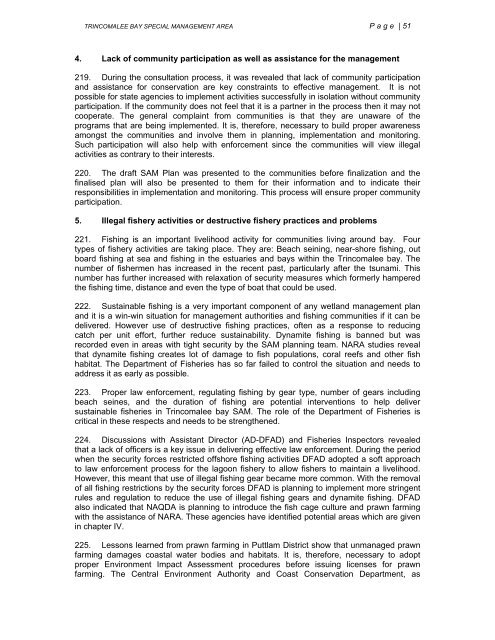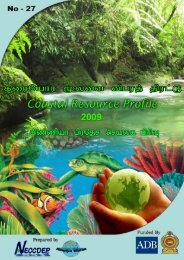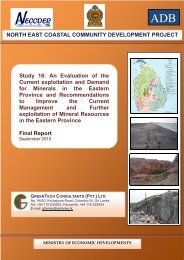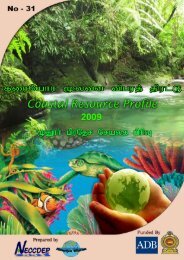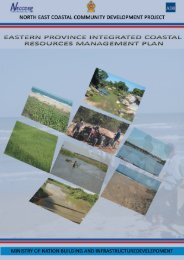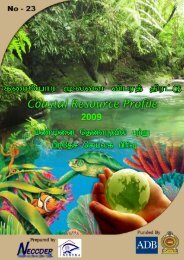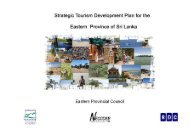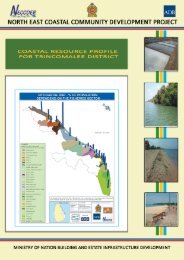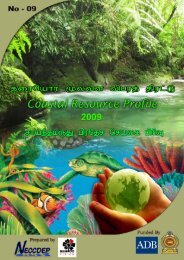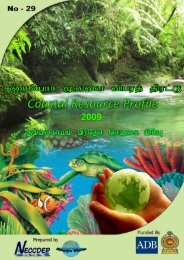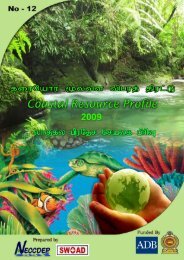Untitled - Neccdep.com
Untitled - Neccdep.com
Untitled - Neccdep.com
Create successful ePaper yourself
Turn your PDF publications into a flip-book with our unique Google optimized e-Paper software.
TRINCOMALEE BAY SPECIAL MANAGEMENT AREA Page | 51<br />
4. Lack of <strong>com</strong>munity participation as well as assistance for the management<br />
219. During the consultation process, it was revealed that lack of <strong>com</strong>munity participation<br />
and assistance for conservation are key constraints to effective management. It is not<br />
possible for state agencies to implement activities successfully in isolation without <strong>com</strong>munity<br />
participation. If the <strong>com</strong>munity does not feel that it is a partner in the process then it may not<br />
cooperate. The general <strong>com</strong>plaint from <strong>com</strong>munities is that they are unaware of the<br />
programs that are being implemented. It is, therefore, necessary to build proper awareness<br />
amongst the <strong>com</strong>munities and involve them in planning, implementation and monitoring.<br />
Such participation will also help with enforcement since the <strong>com</strong>munities will view illegal<br />
activities as contrary to their interests.<br />
220. The draft SAM Plan was presented to the <strong>com</strong>munities before finalization and the<br />
finalised plan will also be presented to them for their information and to indicate their<br />
responsibilities in implementation and monitoring. This process will ensure proper <strong>com</strong>munity<br />
participation.<br />
5. Illegal fishery activities or destructive fishery practices and problems<br />
221. Fishing is an important livelihood activity for <strong>com</strong>munities living around bay. Four<br />
types of fishery activities are taking place. They are: Beach seining, near-shore fishing, out<br />
board fishing at sea and fishing in the estuaries and bays within the Trin<strong>com</strong>alee bay. The<br />
number of fishermen has increased in the recent past, particularly after the tsunami. This<br />
number has further increased with relaxation of security measures which formerly hampered<br />
the fishing time, distance and even the type of boat that could be used.<br />
222. Sustainable fishing is a very important <strong>com</strong>ponent of any wetland management plan<br />
and it is a win-win situation for management authorities and fishing <strong>com</strong>munities if it can be<br />
delivered. However use of destructive fishing practices, often as a response to reducing<br />
catch per unit effort, further reduce sustainability. Dynamite fishing is banned but was<br />
recorded even in areas with tight security by the SAM planning team. NARA studies reveal<br />
that dynamite fishing creates lot of damage to fish populations, coral reefs and other fish<br />
habitat. The Department of Fisheries has so far failed to control the situation and needs to<br />
address it as early as possible.<br />
223. Proper law enforcement, regulating fishing by gear type, number of gears including<br />
beach seines, and the duration of fishing are potential interventions to help deliver<br />
sustainable fisheries in Trin<strong>com</strong>alee bay SAM. The role of the Department of Fisheries is<br />
critical in these respects and needs to be strengthened.<br />
224. Discussions with Assistant Director (AD-DFAD) and Fisheries Inspectors revealed<br />
that a lack of officers is a key issue in delivering effective law enforcement. During the period<br />
when the security forces restricted offshore fishing activities DFAD adopted a soft approach<br />
to law enforcement process for the lagoon fishery to allow fishers to maintain a livelihood.<br />
However, this meant that use of illegal fishing gear became more <strong>com</strong>mon. With the removal<br />
of all fishing restrictions by the security forces DFAD is planning to implement more stringent<br />
rules and regulation to reduce the use of illegal fishing gears and dynamite fishing. DFAD<br />
also indicated that NAQDA is planning to introduce the fish cage culture and prawn farming<br />
with the assistance of NARA. These agencies have identified potential areas which are given<br />
in chapter IV.<br />
225. Lessons learned from prawn farming in Puttlam District show that unmanaged prawn<br />
farming damages coastal water bodies and habitats. It is, therefore, necessary to adopt<br />
proper Environment Impact Assessment procedures before issuing licenses for prawn<br />
farming. The Central Environment Authority and Coast Conservation Department, as


